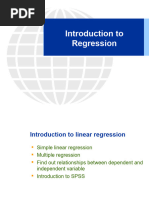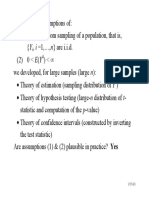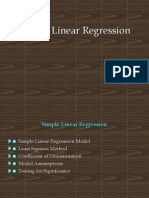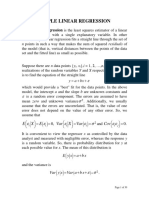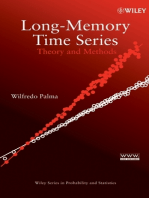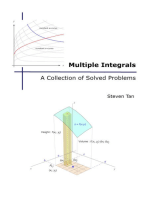0 ratings0% found this document useful (0 votes)
16 viewsRegression Formulas Quick Notes Simplified
Uploaded by
pooja2602patilCopyright
© © All Rights Reserved
Available Formats
Download as PDF, TXT or read online on Scribd
0 ratings0% found this document useful (0 votes)
16 viewsRegression Formulas Quick Notes Simplified
Uploaded by
pooja2602patilCopyright
© © All Rights Reserved
Available Formats
Download as PDF, TXT or read online on Scribd
You are on page 1/ 1
Topic Formula Description
Simple Linear Regression Model Yi = 0 + 1 Xi + ui The regression equation
Estimated Regression Equation i = 0 + 1 Xi Fitted values for the dependent variable
Slope Estimate ( 1) 1 = (Xi - X)(Yi - ) / (Xi - X)² Estimate of the slope of the regression line
Intercept Estimate ( 0) 0= - 1X Estimate of the intercept of the regression line
Residual (Error) ui = Yi - i Difference between actual and predicted values
Total Sum of Squares (SST) SST = (Yi - )² Total variability in the dependent variable
Explained Sum of Squares (SSR) SSR = ( i - )² Variability explained by the regression
Residual Sum of Squares (SSE) SSE = (Yi - i)² Unexplained variability
Relationship (SST, SSR, SSE) SST = SSR + SSE Breakdown of total variation
Coefficient of Determination (R²) R² = SSR/SST = 1 - SSE/SST Proportion of variance explained by the regressio
Error Variance (Residual Variance) s² = SSE / (n - 2)Variance of residuals (used for hypothesis testing and confide
Standard Error of 1 SE( 1) = s / (Xi - X)² Measures the precision of the estimated slope
Standard Error of 0 SE( 0) = s [1/n + X² / (Xi - X)²] Measures the precision of the estimated intercep
t-statistic for 1 t = 1 / SE( 1) Used for hypothesis testing on 1
Confidence Interval for 1 1 ± t( /2, n-2) × SE( 1) Range within which the true 1 lies
Gauss-Markov Theorem OLS estimators are BLUE Best Linear Unbiased Estimators under classical assum
F-statistic for Overall Fit F = [R² / k] / [(1 - R²) / (n - k - 1)] Tests overall significance of the regression
SST, SSR, SSE Relationship SST = SSR + SSE Relationship between total, explained, and residual va
Properties of OLS Estimators E( 0) = 0 and E( 1) = 1 OLS estimators are unbiased
Error Term Assumptions E(ui) = 0, Var(ui) = ², No Autocorrelation Classical linear regression assumptions
You might also like
- Ordinary Least Squares Linear Regression Review: Week 4No ratings yetOrdinary Least Squares Linear Regression Review: Week 410 pages
- Regression Analysis: Basic Concepts: 1 The Simple Linear ModelNo ratings yetRegression Analysis: Basic Concepts: 1 The Simple Linear Model4 pages
- Theory 3. Linear Regression With One Regressor (Textbook Chapter 4)No ratings yetTheory 3. Linear Regression With One Regressor (Textbook Chapter 4)41 pages
- Financial Data Analysis Unit e LecturesNo ratings yetFinancial Data Analysis Unit e Lectures36 pages
- Simple Linear Regression and Multiple Linear Regression: MAST 6474 Introduction To Data Analysis INo ratings yetSimple Linear Regression and Multiple Linear Regression: MAST 6474 Introduction To Data Analysis I15 pages
- Stock and Watson - Slides For Chapter 4No ratings yetStock and Watson - Slides For Chapter 443 pages
- Slides Prepared by John S. Loucks St. Edward's UniversityNo ratings yetSlides Prepared by John S. Loucks St. Edward's University48 pages
- SimpleLineaReg Example 5b027145e190ed456c0d0c9a3b3dd24fNo ratings yetSimpleLineaReg Example 5b027145e190ed456c0d0c9a3b3dd24f3 pages
- Chapter 9 Simple Linear Regression and Correlation (1) (1)No ratings yetChapter 9 Simple Linear Regression and Correlation (1) (1)56 pages
- Regression Analysis and Multiple Regression: Session 7No ratings yetRegression Analysis and Multiple Regression: Session 7100 pages
- File4-Session3-Introduction To RegressionNo ratings yetFile4-Session3-Introduction To Regression50 pages
- The Bucharest University of Economic Studies Bucharest Business School Romanian - French INDE MBA ProgramNo ratings yetThe Bucharest University of Economic Studies Bucharest Business School Romanian - French INDE MBA Program67 pages
- 328formulas03 (2019 - 04 - 03 15 - 13 - 21 UTC)No ratings yet328formulas03 (2019 - 04 - 03 15 - 13 - 21 UTC)12 pages
- Regression Basics: Predicting A DV With A Single IVNo ratings yetRegression Basics: Predicting A DV With A Single IV20 pages
- LinearStatisticalModels and Regression AnalysisNo ratings yetLinearStatisticalModels and Regression Analysis27 pages
- Simple Linear Regression - Lecture NotesNo ratings yetSimple Linear Regression - Lecture Notes19 pages
- Econometrics: Two Variable Regression: The Problem of EstimationNo ratings yetEconometrics: Two Variable Regression: The Problem of Estimation28 pages
- An Introduction To Statistical LearningNo ratings yetAn Introduction To Statistical Learning19 pages
- Student Solutions Manual to Accompany Economic Dynamics in Discrete Time, secondeditionFrom EverandStudent Solutions Manual to Accompany Economic Dynamics in Discrete Time, secondedition4.5/5 (2)
- Complete Download Business Mathematics and Statistics 1st Edition - eBook PDF PDF All Chapters100% (3)Complete Download Business Mathematics and Statistics 1st Edition - eBook PDF PDF All Chapters66 pages
- The Effect of Human Development Index On Corruption in ASEAN CountriesNo ratings yetThe Effect of Human Development Index On Corruption in ASEAN Countries4 pages
- 2020 - 2 - Friend or Foe The Divergent Effects of FinTech On Financial StabilityNo ratings yet2020 - 2 - Friend or Foe The Divergent Effects of FinTech On Financial Stability19 pages
- Impact of Job Satisfaction On Employee Performance NewNo ratings yetImpact of Job Satisfaction On Employee Performance New12 pages
- 14 Factors Influencing Consumers' Choice of Ice Cream A Study On ImpulseNo ratings yet14 Factors Influencing Consumers' Choice of Ice Cream A Study On Impulse19 pages
- Ewunetu FINAL MScThesis Doc IDNo BDU0602175PRNo ratings yetEwunetu FINAL MScThesis Doc IDNo BDU0602175PR94 pages
- R Linear 0.961 R Quadratic 0.989 R2 Cubic 0.991No ratings yetR Linear 0.961 R Quadratic 0.989 R2 Cubic 0.9917 pages
- Coaching Actuaries Exam SRM Suggested Study Schedule: Phase 1: LearnNo ratings yetCoaching Actuaries Exam SRM Suggested Study Schedule: Phase 1: Learn4 pages
- Pengaruh Job Crafting Terhadap Work Engagement P Ada Karyawan Bagian IT PT XNo ratings yetPengaruh Job Crafting Terhadap Work Engagement P Ada Karyawan Bagian IT PT X8 pages
- Solutions Manual to accompany Applied Multivariate Statistical Analysis 6th edition 0131877151 - Read Directly Or Download With One Click100% (4)Solutions Manual to accompany Applied Multivariate Statistical Analysis 6th edition 0131877151 - Read Directly Or Download With One Click36 pages
- Economics For Managers: The Demand Equation Estimation ContinuedNo ratings yetEconomics For Managers: The Demand Equation Estimation Continued25 pages
- Download Biodiversity Economics Principles Methods and Applications 1st Edition Andreas Kontoleon ebook All Chapters PDFNo ratings yetDownload Biodiversity Economics Principles Methods and Applications 1st Edition Andreas Kontoleon ebook All Chapters PDF71 pages
- Principles and Procedures of Statistics: With Special Reference To The Biological SciencesNo ratings yetPrinciples and Procedures of Statistics: With Special Reference To The Biological Sciences509 pages
- Instructorsmanualforprinciplesofeconometricsfourtheditionwilliame 150910183908 Lva1 App6892 PDF100% (5)Instructorsmanualforprinciplesofeconometricsfourtheditionwilliame 150910183908 Lva1 App6892 PDF620 pages























